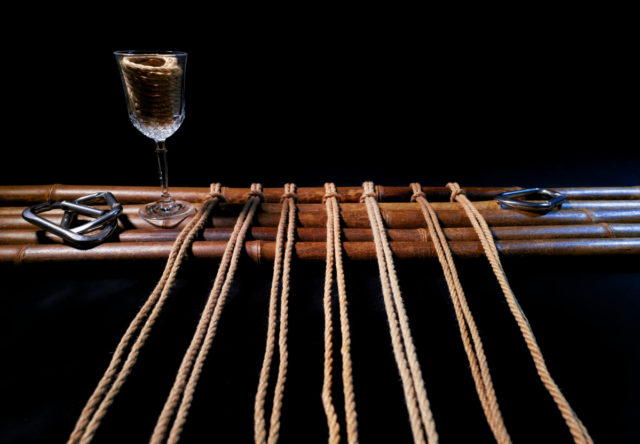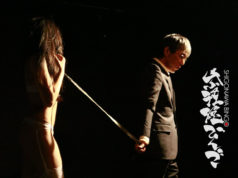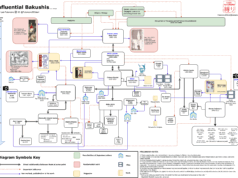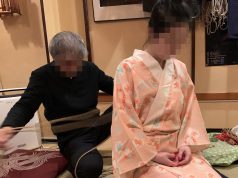“Which rope should I buy?”
This is quite often the most asked question that I see on internet forums related to rope bondage, or that people discuss in person that are new or experienced in shibari/kinbaku.
Whether you tie or are tied, finding the appropriate rope for you and your preferred use for that rope can be confusing because there are so many choices.
Hemp? Jute? Nylon? Cotton? Silk? Sisal? Polypropylene? Polyester? Aramid? Single braid? Plaited? Twisted? Double braid? Hollow? Natural color? Red? Blue? Pink? Yellow? Black? Purple? Blue? Green? Combination colors? Unconditioned? Conditioned? Treated with wax? Treated with natural oils? Fuzzy? Smooth? Order by the spool? Order single ropes? Buy at a local hardware store? Online through a bondage rope vendor? At a local fetish shop?
If you perform a search on your preferred internet browser using the term “bondage rope vendors,” you might get even more confused as you are presented with numerous pages and links to an endless list of purchasing options, distributors, opinions, and reviews. All of which claim that their product is the best.
The rope market is an estimated $1.4 billion dollar business (as of 2019) comprised primarily of industrial, commercial and residential customers. Rope used for bondage is a sliver of the residential market segment with a potential 50,000 customers world-wide.
This article is an attempt to assist some of those 50,000 rope bondage afficionados with a response to the question at hand by comparing jute rope from several well-known vendors through a unique evaluation method, a “Rope Tasting,” to identify the flavor of the rope most preferred.
A Typical Serving
Six evaluators (three pairs of two people) comprised of those that tie and are tied, were assembled from the local South Florida rope group to participate. I coordinated the event and documented the comments and results.
Participants were instructed to close their eyes as I opened a sealed plastic bag containing a single 8m length of 6mm-6.5mm conditioned unused rope. Ropes were purchased new from seven well known rope vendors selected for their brand recognition and popularity. The ropes were randomly labeled as ropes A-G. The three pairs were not told where the ropes originated until the end of the comparison when the ratings and point totals were revealed.
Each pair inhaled the aroma of the rope as the bag was held close to their nose, similar to inhaling a fine wine. The same was done for other ropes in each “serving” (round) allowing them to evaluate the Scent of each rope.
The ropes were then taken out of the plastic bags and placed on the floor in front of the pairs under bright lights. Pairs were encouraged to comment on the ropes without touching them based on visual observation so that they could judge the Appearance.
Each pair was then allowed to touch the ropes individually to assess Pliancy.
The pairs then took turns doing simple one rope ties with the ropes to get sense of the Feel on the Skin of the person tying and being tied as well to determine if the Hairiness of the rope was an issue.
A single representative rope from a vendor was compared to another in a one vs. one “tasting” lasting seven “servings,” with the most preferred “flavor of rope” advancing to the next round to face a new challenger. This continued until one vendor product was deemed the rope to buy using the rating/point system
Excellent (4 points)
Good (3 points)
Fair (2 points)
Poor (1 point)
Each individual category was rated and at the end of the comparison, all the points were added providing a final ranking for each vendor’s rope.
Results from Least to Most Flavorful Rope
Damn Good Rope Company – 6th Place
What They Liked
Not applicable.
What They Didn’t Like
Pair 1 – “Rope A smells fuelly. It smells vinegary.”
Pair 1 – “It’s hairy and stiff. The lay is uneven. I can tell now that I’m holding it. It looks like it was made badly with a machine.”
Pair 1 – “It feels rough like coconut rope.”
Pair 2 – “The strong smell from rope A is triggering my allergies.”
Pair 2 – “For something brand new, rope A looks used.”
Pair 2 – “Rope A is rough. It feels hard. I don’t like it, it feels tight and stiff.”
Bottom Line
A very strong burnt smell along with a sooty appearance and rough texture resulted in the lowest score resulting in a quick elimination in the first serving. Value for the price is not there as a single rope cost as much as ropes that scored higher.
ESINEM ROPE – 5th Place
What They Liked
Pair 1 – “It doesn’t smell as bad as rope A.”
Pair 2 – “It feels better for tying in my hands than rope B because it’s pliable.”
What They Didn’t Like
Pair 1 – “Wow. It’s very pliable. It feels like it’s been used a bunch of times already. Not a good thing. Not a good at all.”
Pair 3 – “It smells like rancid oil that did not cure properly.”
Pair 3 – “It looks too singed. It has soot in the creases. And it looks like it didn’t dry properly. It looks charred. Like it was singed too long. It does look less hairy than rope B.”
Pair 3 – “It feels broken in, but textured and rough. It looks like poor quality jute because of how dirty it is. It is looser than rope B, but it looks more uniform.”
Bottom Line
Introduced in the second serving, the rope scored a Good rating by one point. Value for price is mixed as the price is less than other competitors, but the trade off in quality may not be enough for some. Appeared in the second serving and was eliminated.
Ogawa – 4th Place
What They Liked
Pair 1 – “It feels smooth when I tie. It’s a little bit thicker than I would normally use. It feels like it will flow smoothly.”
Pair 2 – “It smells like a lighter version of rope D.”
Pair 3 – “It smells warm and earthy. Most pleasant that I smelled so far.”
What They Didn’t Like
Pair 1 – “It looks so fuzzy.”
Pair 3 – “It looks like it’s broken. It looks frizzy.”
Pair 3 – “It feels good. Less scratchy than rope D.”
Bottom Line
The rope came untreated as 6.5mm and was conditioned with wax after purchase. Appearing in the fourth serving, it was eliminated by the rope in first place. Value for dollar may be there for some given that the rope scored well in three of the five categories, although it can only be purchased in spools.
Anatomie Rope Shop and MyNawashi – Tied for 3rd Place
What They Liked
Pair 1 – “I like it. It feels like it would break in nicely.”
Pair 1 – “It feels not particularly great. But not bad.”
Pair 2 – “B looks cleaner than A.
Pair 3 – “It’s a lot softer than when you see it. This would change my thoughts about putting it on someone.”
Pair 3 – “This looks more comfortable to tie with.”
What They Didn’t Like
Pair 2 – “This needs to be broken in. It’s stiff. It buckles a little when you make a loop and try to pass the rope. I would stick to ground work only with this.”
Bottom Line
The winner of the first and second servings (beating out Damn Good Rope Company and ESINEM ROPE), it was eliminated in the third serving by the rope in first place. Similar in price to Damn Good Rope Company, the rope’s scores might justify the cost.
What They Liked
Pair 2 – “It is slightly scratchy, but not in a bad way.”
What They Didn’t Like
Pair 1 – “It smells like chemicals. It smells off.”
Pair 3 – “It has more of a JBO smell, but not like rope A’s amount.”
Pair 3 – “It feels prickly. Not consistent. Some parts feel sharp. I would get irritated over time.”
Bottom Line
Like Ogawa, this rope came untreated and was conditioned with wax after purchase.
Introduced in the seventh serving and going head-to-head with the first-place rope, this was the surprise entry. It has the best value for dollar as it costs 1/3 to 1/5th the price of its competitors making it the winner for value to price. It might be a good rope for beginners interested in learning rope bondage as a full set can be purchased without having to spend a lot of money.
NAWAYA – 2nd Place
What They Liked
Pair 1 – “It smells clean and subtle.”
Pair 2 – “It feels very good. Not rough. It is not hairy or weird.”
Pair 2 – “Whatever they used, it was a natural product.”
Pair 2 – “It is a tighter weave. It looks soft and pleasant and easy to work with.”
Pair 2 – “OMG! You can do a lot with this! It is very easy to work with. Very flexible and I don’t think it gives resistance. You can enjoy playing with it or use it for artsy style of rope. If you want to do really tight angles, it’s gonna look very camera ready. You can do everything with it.”
Pair 3 – “It is not going to overstimulate your sense of smell.”
What They Didn’t Like
Pair 1 – “It is scratchy. More than I thought it would be.”
Pair 3 – “It is scratchy. I feel bumps. Running my hands through it, some parts are tighter than others.”
Bottom Line
Introduced in the fifth round, it too was eliminated by the first-place rope. A solid choice and only three points shy of being rated Excellent due to the hairy/scratchy feel of the rope. Value for price is there and it would have been the rope flavor of choice if the first-place rope had not been developed.
AMATSUNAWA’s Jouyoku – First Place
What They Liked
Pair 1 – “D smells excellent.”
Pair 1 – “It feels consistently constructed. And the fiber feels like it will sink into itself nicely without slipping or being too tight. This is the first one that I’ve tried that I would buy.”
Pair 1 – “I like it. I don’t know about the hairiness, but it does not feel scratchy. It feels like jute. This feels pretty natural and even on my skin. It feels well balanced. That’s a good word. Yeah.”
Pair 2 – “I can see that it is brand new.”
Pair 2 – “It would be good for photography because the color is light. You can see the strands it and it gives good shadows. It might leave good rope marks afterward.”
Pair 2 – “I like it. No matter how you twist it. It stays sturdy all the way through.”
Pair 3 – “Looks real pretty. I’m more than willing to tie with it.”
Pair 3 – “It feels very good. I like loose rope. The lay and twist is more consistent. The texture is consistent throughout.”
What They Didn’t Like
Pair 3 – “I think it has a tinge of JBO smell.”
Bottom Line
Newly brought onto the market for 2022, the Jouyoko brand rope was introduced in the third serving and eliminated Anatomie Rope shop. It then went on to beat the other ropes in each serving that followed as it was compared to ever increasing competition. Available in 5 diameters ø4.0, 4.5, 5.0, 5.5 and 6.0mm. Good value for price as they can all be purchased in wholesale size spools or mini-rolls (300 or 50m respectively with the ø6mm product).
This rope has set a high benchmark, and the competition will need to raise the bar going forward if they are to beat this excellent product.
“Which rope should I buy?”
This article and the results are by no means meant to be a definitive guide about which rope should be purchased. As the results indicate, the participants had varying opinions about which flavor of rope they liked best.
Ultimately, it comes down to a combination of quality, availability, price, and perceived value for the person buying and using the rope.
I’d like to once again thank the six participants that volunteered for providing their honest ratings and comments. Their evaluations will hopefully provide some valuable guidance to their fellow rope enthusiasts world-wide.
I definitely encourage everyone reading this article to organize their own Rope Tasting event to see if the results are similar and if there is agreement or disagreement with the observations and comments of the participants.
I have provided the website links for the vendors that were evaluated so that they can be contacted. If asked, they might be willing or able to provide free samples to organized rope groups for any future Rope Tasting events.
Links
Darkly_Dreaming is a Miami based rope artist and photographer. Darkly_Dreaming is his artistic name, and Flower and Rope is his brand. His kinbaku journey began in 2018, and he has received the guidance of three talented bakushi allowing him to incorporate elements from their teachings as he develops his own style of expression with rope. He has written several reviews for RopeFlix and is a contributor to Kinbaku Today. Follow him on Instagram at FlowerandRope or at his Personal Website







